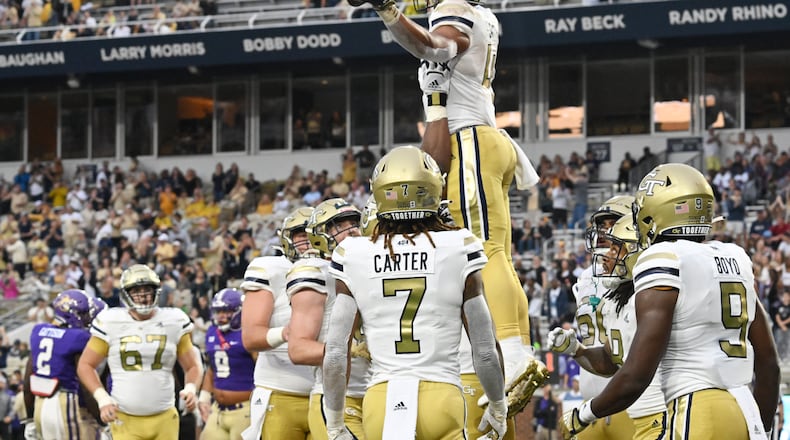When Georgia Tech running back Dontae Smith first learned about the Tech Way, a recently launched collective supporting Yellow Jackets athletes, it didn’t take much for his interest to be piqued. An initiative with the objective of creating name, image and likeness deals for him and other Tech athletes that has the support of the athletic department more or less sells itself.
“At the end of the day, it’s income to you, so why not take it?” Smith said in an interview with The Atlanta Journal-Constitution. As a representative of the Tech Way, “you may have to post (on social media) here and there and do a couple things, but that’s all part of the college football experience anyways. Now you’re able to get income from just doing college football stuff.”
Major Tech donors made initial funding to the collective, which are organizations supported by a school’s boosters with the primary intent of creating NIL deals for the school’s athletes, in January. It folded an earlier collective organization, Swarm the ATL, into its operation. Run by Jason Belzer, CEO of an NIL-focused company that operates collectives at more than 20 Division I colleges, the Tech Way aims to catch up to collectives at ACC and SEC schools that have gained a recruiting advantage over Tech. Belzer said that more than $1 million has been raised thus far.
It’s early, “but I would say that Georgia Tech is in as good a position, operationally, as any collective in the country and every one that we operate,” Belzer told the AJC.
Smith is one of about 30 Tech football players and a handful of men’s and women’s basketball players who have signed deals with the Tech Way, primarily receiving compensation for being ambassadors for the collective to help draw in more funding. Smith’s contract calls for him to make appearances and make social-media posts, among other activities.
“It means a lot,” Smith said. “You’re able to just have a little extra money in your pocket basically just doing football (related activities). Not only me, but it’s good to see my teammates who may not be able to go out and get other deals, but with the Tech Way, they’re able to get deals, too.”
Belzer said it’s likely that every football player and men’s basketball player will have a deal by the end of the year. Offensive tackle Jordan Williams likened it to a bonus.
“I would say you would never want to pick a school based off of NIL or if something’s going with NIL,” he said. “You want to pick a school based on what you like going on. This is just icing on the cake.”
Smith and Williams declined to disclose how much icing they’re receiving. Williams called it money for “groceries and bills and getting your oil changed on your car, something like that.”
Athletic director J Batt has thrown his weight behind the initiative, publicly endorsing the Tech Way and helping send Tech supporters to the operation. Only a couple of years ago, the idea of an athletic director encouraging boosters to fund an initiative that paid his or her school’s athletes would have been unthinkable. But with the dawn of the NIL era, in which NCAA rules permit athletes to be compensated for endorsement deals, that has become standard. In an email sent to supporters in January, Batt wrote that “a robust NIL program is imperative” for Tech to succeed athletically.
Former athletic director Todd Stansbury did not encourage support of collectives in the way that Batt has. Tech alumnus Stephen Weitzel, who helped lead the Swarm the ATL collective, has taken note of Batt’s involvement level.
“It’s really a different ballgame at this point,” Weitzel said. “Having the institutional support and backing is really critical for these efforts to have any legs.”
The Tech Way is working toward an agreement with Legends, which manages Tech’s multimedia rights, to make it the official NIL entity for the institute, a partnership that would allow the collective to be promoted at Tech events.
The idea of paying athletes, particularly out of a collective, a format that has come under criticism for not being true to the intent of allowing athletes to be compensated for the use of their NIL rights, may not sit well with some fans. But it is the reality of the day, and Tech coaches are competing in recruiting against coaches who can point to the NIL deals that their athletes are receiving.
To date, Tech athletes have had the ability to make their own NIL deals (Smith and his fellow running backs had an NIL deal last season with KetteQ, an Atlanta-based supply-chain software company, and Smith has an online merchandise shop selling T-shirts with his nickname “2KTae.”). And while other Tech supporters have attempted collectives, none have had the scale or level of support from Tech’s administration that the Tech Way has enjoyed.
“It just plays a big part (in recruiting), because NIL, you have to bring that up when you’re recruiting,” Smith said. “For us to have something to say about NIL, to have our collective group, to say to these recruits, that just adds on to why you should come to Tech. … It’s a big, vital part in recruiting and putting this program back to where it should be and where it used to be.”
Particularly in the transfer portal, the most sought-after football and men’s basketball players can command six-figure NIL deals. Last summer, Miami landed guard Nijel Pack with a two-year, $800,000 NIL deal from Miami booster John Ruiz, owner of a company in the health-care industry.
Those are outlier deals, though. Belzer said that, based on market data that his business has collected, the average compensation for a football player at a power-conference school supported by a collective is about $15,000. That’s just from money from collectives and doesn’t count other NIL deals. For men’s basketball, the average is closer to $50,000, according to Belzer.
The impact that can have on recruiting is not surprising.
The high-school coach of a sought-after transfer prospect this past offseason told the AJC that his former player had genuine interest in Tech and coach Josh Pastner but ultimately signed with another power-conference school whose boosters offered him a six-figure NIL deal while Tech had nothing to match. That player is now competing for all-conference honors at his school.
“I think that Josh is not playing on an even playing field, that’s for sure,” the coach said.
It may be that, barring a Tech version of John Ruiz stepping forward, Jackets athletes won’t have access to six-figure NIL deals. But Belzer’s ambition is to at least get Tech into the game. He said that he believes that his company, Student-Athlete NIL, has the infrastructure to generate between $3 million to $5 million annually. With most of the money being directed to football – supporters can designate money for a specific player, position group or team or into a general fund – $3 million in revenue might come out to about $25,000 per scholarship player on coach Brent Key’s team.
The operation, though, will depend heavily on contributions (which are not tax-deductible) from a wide base of supporters. The bulk of funding initially has come from a group of current Tech donors. But its future will depend on many more supporters becoming involved. Belzer expects that the major contributions received to this point are one-time payments to get the collective started and won’t be a revenue stream to tap in the future.
“The reality is that in every collective, it’s pretty much like this,” Belzer said. “Most of the money is driven through donors. It’s probably 80/20 is the best way to think about it. And the long-term goal is to create a more sustainable model by having that 80/20 flip to the 80% being members and businesses versus just donors.”
Belzer said that funding is being raised daily through subscription-based memberships, in which supporters pay between $10 and $500 monthly in exchange for items such as invitations to meet-and-greets, apparel and autographed memorabilia. Subscription rates for businesses are between $100 and $1,500 monthly for services such as social-media posts from athletes promoting the business, appearances and tickets to supporter events.
Belzer said that a goal of 1,000 members by the end of the year is “extremely conservative.” For context, Belzer said that two other collectives that he runs, at Oklahoma and Rutgers, have about 2,500 and 1,000 members, respectively. When Batt launched a scholarship drive in late October, almost 2,000 donors contributed in a little more than two months.
“It goes without saying that Georgia Tech student-athletes desire a first-class student-athlete experience,” Batt said in a statement given to the AJC. “NIL opportunities are now a major component of the student-athlete experience, which makes it imperative that we have a robust NIL program. As the landscape of college athletics has evolved, supporting NIL opportunities has become just as vital for student-athlete success as other components of financial support.”
About the Author
Keep Reading
The Latest
Featured


